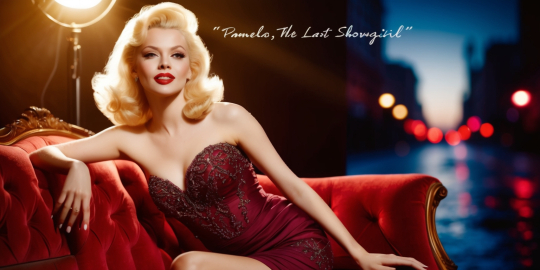
In a world where many public figures find it challenging to shed the shadows of their past, Pamela Anderson has taken a significant leap forward with her latest performance in *The Last Showgirl*. This film, crafted by the visionary director Gia Coppola, serves as a potent vehicle for Anderson to transcend the stereotypes that have long defined her. Not only does it explore the intricacies of life as a performer, but it also cleverly interweaves themes of resilience, motherhood, and self-discovery. Through a lens of vulnerability, the narrative invites viewers to engage deeply with Anderson’s evolution as an artist, making it a compelling watch that resonates in today’s cultural landscape.
The Setting: A Glimpse into Las Vegas
Las Vegas stands as a vibrant backdrop for the film, encapsulating both the glittering allure and the underlying struggles faced by its inhabitants. This vibrant metropolis, famous for its grand and dynamic performances, provides an ideal stage for the character of Shelly, played by Anderson. Here, the audience is introduced to a world filled with dreams, ambitions, and the stark reality of fading stardom.
The Protagonist: Who is Shelly?
Shelly, a professional dancer and singer, is at the center of this narrative. Living in the flashy, often unforgiving environment of Las Vegas, she tries to navigate her career while also acting as a mother figure to two younger performers. Her character reflects not only the trials of show business but the complexities of familial relationships, especially with her own daughter. This duality adds layers to the storytelling that compel viewers to empathize with Shelly’s journey.
A Mother’s Struggle
As Shelly fosters connections with the younger dancers, she grapples with her estranged relationship with her own daughter. This theme of motherhood serves as a poignant exploration of the sacrifices artists often make for their careers, drawing attention to the emotional cost of fame.
The Show’s Demise

The narrative takes a turning point when the show's producer announces its closure. This moment of crisis propels Shelly into a state of uncertainty and self-reflection, forcing her to confront her fears and consider what lies ahead. How she navigates this upheaval becomes a significant arc of the story.
Art Reflects Life: Anderson’s Personal Journey
Anderson brings her real-life experiences into her portrayal of Shelly, enriching her performance with authenticity. She channels years of public scrutiny and personal trials into her character, imbuing Shelly with a mixture of hope and disillusionment. This reflection on ageism and the inevitable passage of time in the entertainment industry resonates deeply, giving the film an almost autobiographical touch.
Optimism vs. Reality
Despite facing numerous challenges, Shelly embodies an enduring spirit of hope. This dynamic is expertly showcased through Anderson’s performance, as audiences witness the gradual ebbing of Shelly’s optimism. Watching her navigate through both the highs and lows offers a powerful emotional experience that emphasizes the harsh realities of show business.
Supporting Cast: Strengths and Weaknesses
While Pamela Anderson's performance shines brightly, the supporting cast presents a mixed bag. Characters portrayed by actors like Brenda Song and Kiernan Shipka contribute to the story but sometimes lack the depth necessary for a fully engaging narrative. Shipka, in particular, puts forth an earnest effort, although her character's development feels somewhat underexplored.
The Impact of Eddie
Dave Bautista’s character, Eddie, serves as a central character in the story. His engagements with Shelly offer moments of emotional resonance and depth. Bautista excels in portraying vulnerability, showcasing his growth as a character actor and providing a grounding presence amid the chaos of the performers’ lives.
Coppola’s Direction: Hits and Misses
Gia Coppola’s vision for *The Last Showgirl* is ambitious, but certain elements fall short. While she expertly captures the essence of Shelly's struggles, some scenes feel disjointed. The film grapples with pacing issues and a visual style that occasionally feels muddled, making it difficult for the audience to completely engage with the environment Coppola aims to create.
Visuals: A Mixed Palette
The film’s cinematography presents a striking yet uneven visual landscape. Certain sequences shine, especially in intimate moments, while others appear chaotic and distracting. This inconsistency can detract from the storytelling and pull viewers out of the emotional experience the film strives to deliver.
Dialogue and Character Development
The dialogue among the characters sometimes lacks the nuance necessary for effective storytelling. While moments of tragedy are intended to be impactful, they occasionally come off as abrupt, making it difficult for the audience to form a profound bond with the characters’ experiences. A more polished script could have elevated these pivotal moments.
What Makes *The Last Showgirl* Special?
Despite its flaws, *The Last Showgirl* emerges as a conversation starter about the treatment of women in entertainment and their search for identity. Pamela Anderson’s performance becomes the heart of the film, allowing audiences to witness a maturation process that feels both genuine and inspirational.
Final Thoughts: Essential Viewing
In summary, *The Last Showgirl* is an essential viewing experience, primarily due to Pamela Anderson’s groundbreaking performance. It serves as both a poignant character exploration and a wider critique on the challenges faced by women in the entertainment field. The movie will connect with audiences who value narratives of resilience and growth, making it one of the must-see films in the upcoming cinematic landscape.
The Release Date
*The Last Showgirl* is set to grace theaters on December 13, 2024, distributed by Roadside Attractions. It promises to be a captivating experience that highlights Pamela Anderson’s undeniable talent and the timeless influence of narrative in film.